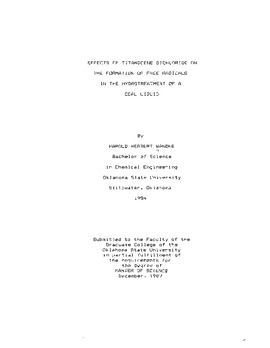| dc.description.abstract | In hydrotreatment, coking is a major mechanism for catalyst deactivation. Titanocene dichloride has been shown to reduce catalyst coking and to increase hydrotreatment activity. In this study, the effects of titanocene dichloride upon the hydrotreatment of an SRC-II Middle Distillate were investigated, with special attention paid to the phenomenon of product free radical concentration during the catalytic and non-catalytic hydrotreatment processes. The hydrotreated products were analyzed for elemental composition, boiling point distribution, free radical concentration, and iron and titanium concentration. Spent catalyst was analyzed for coke content, surface area, pore volume, and titanium distribution. Variables investigated included the effects of sulfidation time, feed doping with titanocene dichloride, reaction temperature, space time, and gas type upon the hydrotreatment process. Titanocene dichloride increased the efficiency of the hydrogenation, hydrodenitrogenation, and hydrodeoxygenation reactions during catalytic hydrotreatment, while increasing the amount of the low-boiling fractions of the product. During non-catalytic hydrotreatment, titanocene dichloride decreased the amount of the high-boiling fractions in the product. Monitoring of the presence of free radicals in the product indicated that the relative concentration of free radicals was constant from room temperature up to 250 C; increased significantly from 250 c to 350 c; and decreased from 350 C to 400 C. The presence of catalyst in the reactor significantly reduced product free radical concentration. Titanocene dichloride in the presence of molecular hydrogen significantly increased the free radical concentration at 250-350 C in a non-catalytic environment. No titanium survived catalytic hydrotreatment. Titanium concentration of the non-catalytic hydrotreated product remained constant from room temperature up to 250 C, and decreased drastically above 250 C. | |
